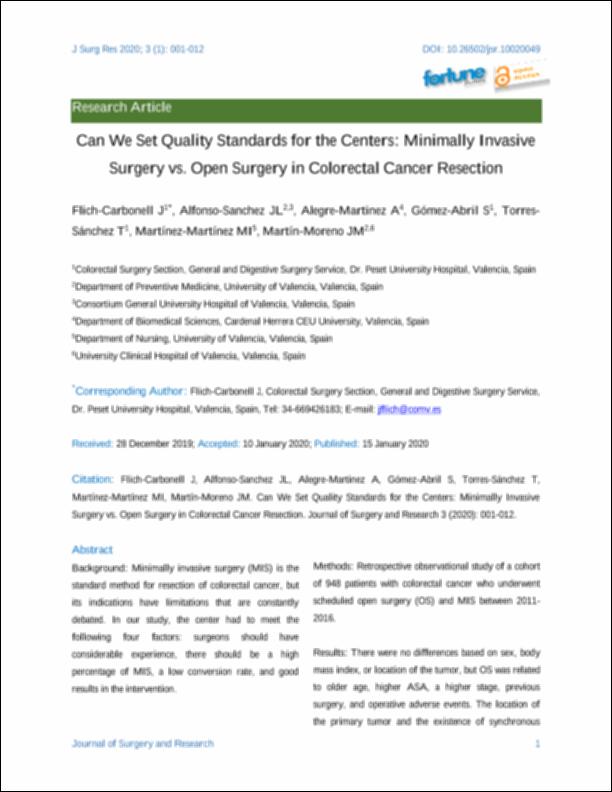Por favor, use este identificador para citar o enlazar este ítem:
http://hdl.handle.net/10637/12855Can we set quality standards for the centers : minimally invasive surgery vs. open surgery in colorectal cancer resection
| Título : | Can we set quality standards for the centers : minimally invasive surgery vs. open surgery in colorectal cancer resection |
| Autor : | Flich Carbonell, Juan Alfonso Sánchez, José L. Alegre Martínez, Antoni Gómez Abril, Segundo Torres Sánchez, María Teresa Martínez Martínez, María Isabel Martín Moreno, José María |
| Materias: | Colon - Cáncer - Cirugía.; Surgery, Operative.; Cirugía operatoria.; Colon (Anatomy) - Cancer - Surgery. |
| Editorial : | Fortune Journals. |
| Citación : | Flich-Carbonell, J., Alfonso-Sánchez, J.L., Alegre-Martínez, A., Gómez-Abril, S., Torres-Sánchez, T., Martínez-Martínez, M.I. et al. (2020). Can we set quality standards for the centers: minimally invasive surgery vs. open surgery in colorectal cancer resection. Journal of Surgery and Research, vol. 3, i. 1 (15 jan.), pp. 01-12. DOI: https://doi.org/10.26502/jsr.10020049 |
| Resumen : | Background: Minimally invasive surgery (MIS) is the standard method for resection of colorectal cancer, but its indications have limitations that are constantly debated. In our study, the center had to meet the following four factors: surgeons should have considerable experience, there should be a high percentage of MIS, a low conversion rate, and good results in the intervention. Methods: Retrospective observational study of a cohort of 948 patients with colorectal cancer who underwent scheduled open surgery (OS) and MIS between 2011-2016. Results: There were no differences based on sex, body mass index, or location of the tumor, but OS was related to older age, higher ASA, a higher stage, previous surgery, and operative adverse events. The location of the primary tumor and the existence of synchronous tumors were related to variability in the technique. The implementation of MIS increased from 36.2% in 2011 to 89.6% in 2016. The surgeon's experience decreased the conversion rate from 6.5% in 2011 to 3.1% in 2016, with 2% in T0-2 tumors. In logistic regression, the factor that most increased the possibility of choosing MIS was the pT grade of the tumor, and the factors that most contraindicated MIS were stages 2-4, ASA 4, stage 1, previous surgery, and advanced age. Conclusions: In hospitals where surgeons have long experience, minimally invasive surgery could be implemented in up to 90% of cases, with low conversion rates (3-4%) and good results for patients. |
| Descripción : | Esta comunicación se encuentra disponible en la siguiente URL: https://www.fortunejournals.com/articles/can-we-set-quality-standards-for-the-centers-minimally-invasive-surgery-vs-open-surgery-in-colorectal-cancer-resection.pdf |
| URI : | http://hdl.handle.net/10637/12855 |
| Derechos: | http://creativecommons.org/licenses/by/4.0/deed.es |
| ISSN : | 2640-1002. |
| Fecha de publicación : | 15-ene-2020 |
| Centro : | Universidad Cardenal Herrera-CEU |
| Aparece en las colecciones: | Dpto. Ciencias Biomédicas |
Los ítems de DSpace están protegidos por copyright, con todos los derechos reservados, a menos que se indique lo contrario.


